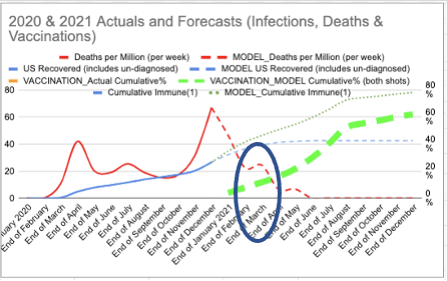As part of a continuing series in Research World, this is the monthly update of my COVID-19 forecast. As always, drop me a note if you have questions or points of view on my model forecast. I’ve made the model open and free, so use it in any way that is helpful to you. You can read this post at https://speakerrex.com/April1Update.html along with last month’s post and my daily updating dashboard.
Facts & Forecasts:
Looking forward, the 30 day Briggs-3 forecast for April 30, 2021 is 577,938 (30,932 incremental deaths from COVID-19). IHME forecast is very close, with 574,744 (29,608 incremental).
Looking forward 90 days, The forecast for June 30th is 602,712 for Briggs-3 (an incremental 51,074). IHME forecasts 600,053 (48,415 incremental). These forecasts are remarkably close.
For Briggs-3, the year-end forecast is 626,577. This is a reduction from last month’s forecast and is much closer to the original 2021 forecast of 601,000 from November 2020. That said, there are risks that we could trend back upward if vaccinations stall or are ineffective against variants.
Looking backward, over the past 30 days, for the month of March, the Briggs-3 model forecast was about 12% lower than actual deaths (the model predicted 32,602 incremental deaths vs 37,234 actual). The Briggs-3 model outperformed the IHME model, which forecasted, which is off by 17%.
Overall, looking at absolute difference between each monthly projection since November, the 30 day forecast for Briggs-3 has averaged within 95% of actual. The IHME has averaged 86% of actual. Examining the absolute difference since November, the 90 day forecast for Briggs-3 has averaged within 86% of actual. The IHME has averaged 72% of actual. The Briggs-3 model continues to be among the most accurate, however there is a slight optimistic bias, based on the actuals vs. forecast over the past year.
Observations & Commentary:
The reason for the significant drop in deaths for the Briggs-3 forecast is that the 65+ population has already reached 50% fully vaccinated. The Briggs-3 model expected 50% to be reached on May 10th, and 75% to reached toward the end of the year. This means the US is now ahead of the model forecast for vaccinations of the most at-risk population (those 65 and older).
The Briggs-3 model had a “best case” scenario of 85% of 65+ fully vaccinated by the end of the year. At this level, the model predicted about 130,000 incremental lives saved compared to the 75% level. Let’s do everything we can to help those most at risk to get fully vaccinated. It can make a huge difference in lives saved.
The reason the vaccination rate of 65+ is so important to the model prediction is 65+ have represented 80% of all deaths thus far. They are nearly 100x more likely to die of COVID compared to someone under 45. With a high vaccination rate, the model predicts the Infection Fatality Rate (IFR) will drop in half.
The Briggs-3 models shows more lives are now being saved by the incremental vaccines than are lost to the disease. As of today, the model calculates 759,254 deaths averted in the US due to vaccinations. The fact that we are only four months into vaccinations and more lives have been saved due to people getting vaccinated than have been lost to COVID-19 is inspiring.
The Briggs-3 model does expect vaccinations to slow as the US approaches 45 to 50% of total US population vaccinated. The forecasted vaccination curve is informed by pattern of flu vaccinations by month. To read more about this forecast, see the forecast blog, link of the bottom left of dashboard. The Briggs-3 model includes public health communications from organizations like the Ad Council that are making a great effort to get the facts out. These PSAs could increase the vaccination rate by 20% to 40% over baseline.

In Europe, the story is different. The rate of vaccination is significantly behind model expectations. This can be turned around. In the US, back in January, due to slow vaccinations and the spread of dangerous variants, the US was trending toward the model’s worst case scenario. However, By the end of February, the US quadrupled vaccination rates and got back on track. In particular, the vaccination rates among 65+ were outstanding.
The projection is for the US to see an effective end to the pandemic in early Q3, as originally forecast in November is on track. (You can see the original Research World Article here: https://archive.researchworld.com/author/rex-briggs/ ). For Europe, the expectation is for vaccinations to pick up substantially in Q2 and Q3 with an effective end to the pandemic toward the end of Q3 – still within the original forecast window, but with a higher loss of life due to the slow vaccine roll-out.
To track the progress of vaccinations in the US, see www.speakerrex.com/dash.html and click on vaccinations to page through the charts and data.
We are not out of the woods yet. The recent uptick in cases and deaths is unfortunate but was predicted back in the November model (see circled portion of chart, showing trend in COVID deaths per million).

This recent uptick will not translate into nearly as many deaths as other holidays because vaccinations of 65+ is ahead of forecast. My analysis of the Washington State breakthrough cases among those fully vaccinated suggests the vaccinations are currently 97% effective at preventing COVID-19 and lessening the severity of outcomes. The US now has over 50% of the 65+ population fully vaccinated.
Unfortunately, my analysis is finding a confounding factor with the first dose of the vaccine that actually increases SARS-CoV-2 infections. There is a positive correlation with the US States with case increases and the first dose which I believe is caused by people becoming being less vigilant about social distancing and mask wearing when a loved one gets vaccinated. In my household, with twin 18-year-old boys, about 10 days after my first jab, they asked if they could join a few of their friends for dinner. I was more willing to let them. I don’t think they would have asked, or I would have said “yes” prior to the vaccine. Looking at the data on cases surges correlated with first vaccination, I realize it is premature to let our guard down after the first vaccination.
It is worth considering how our mask wearing and social distancing aids the vaccine in achieving the 97% efficacy observed in Phase 3 trials. The data on effectiveness depends on the overall background behaviors, and it may be wise to continue to wear masks until cases are down to a much lower number. This may be politically unpopular as death tolls drop, but considering the virus will have evolutionary pressure to find a way to causes infections in spite of vaccinations, we can reduce the changes of a dangerous mutation by maintaining a level of social distancing, mask wearing, hand washing, etc.
Analyzing vaccination rates by population factors, my analysis finds Black Americans continue to have a negative correlation, however, I am seeing indications in the vaccination date and polling feedback that Black Americans changing their stance on vaccines.
The analysis of population factors is showing a concerning trend among conservatives in the US. Corresponding with the change in the Presidency, conservatives, particularly less educated conservatives, have shifted from being ahead on vaccinations to now being behind. My analysis shows a shift from a positive correlation with vote margin for Trump in 2020 election and vaccination rates to now a significantly negative correlation. Polling data is corroborating this pattern. The shift occurred in February and March, which suggests that the people aligned with the opposition to the party in power may be more hesitant to be vaccinated. It is unclear whether this will be a global pattern, or if this is a local phenomenon, only applicable to the US. It is worth considering how to transcend politics in ensuring broad scale vaccinations to end the pandemic.
The medical research from Israel, the UK and data from Washington state shows that vaccinations reduce the likelihood of getting infected, so we should continue to see infections trend downward as vaccinations increase. It is important to consider what we can do to ensure the benefits of vaccination are broadly and equitably administered.
Concluding Thoughts:
If you’ve already been vaccinated, Right on! Consider if you can help others to get vaccinated. Maybe it is helping make an appointment. Maybe it is helping to arrange transportation. Maybe it is helping get answers. Ad Council’s “It’s Up To You” (https://www.adcouncil.org/covid-vaccine) site is a great place to start.
If you’ve been vaccinated, keep your guard up until a full two weeks after the second dose, and encourage other family members to do the same. Look outside the US and consider how we might help others around the world to get vaccinated sooner. This is a global fight.
We certainly have done a lot to reduce the death toll in the US, and we should be asking how we can help save lives globally. Besides valuing lives beyond our borders, helping with global vaccination is in our interest in protecting ourselves and our families. As long as the virus is spreading it has the risk of mutating. Now that we have effective vaccines, we are in a race against the virus. It’s up to us to end this.


